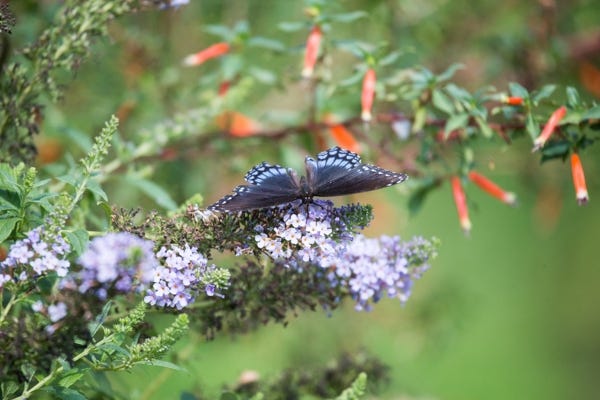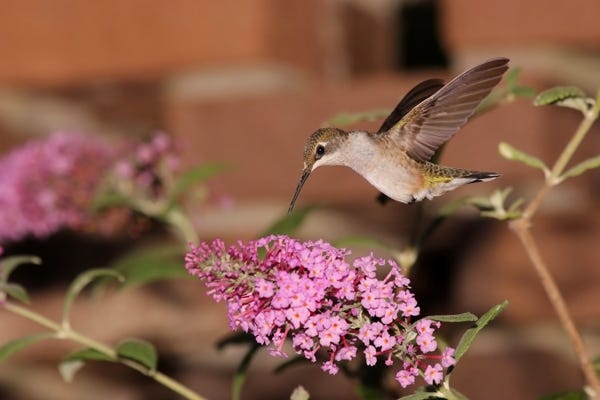Planting Shrubs in Fall

By Marianne Willburn, gardening expert and author.
Butterfly Bush, Hydrangea, Forsythia, Beauty Berry, Viburnum, and more! A shrub by definition is a woody, multi-stemmed plant, either deciduous or evergreen, that can grow from just a few inches high to over ten feet tall.
Shrubs offer much for your garden – privacy, contrast, scent, texture, flower, windscreen, shade, erosion control, and of course, the ‘wow’ factor. There’s a lot to think about when we’re investing in shrubs that will beautify and shape our landscapes for years to come - so we'll help you choose well and plant well.
Why Plant Shrubs in the Fall?
Certainly it is tempting to put thoughts of next year’s garden on hold for winter dreaming and spring planting, but gardeners who capitalize on the fall planting season take advantage of many opportunities the spring just can’t afford.
Most importantly, still-warm soil and lower air temperatures give hardy shrubs a huge advantage in establishing strong root systems. Pest populations are lower, competition from tall summer weeds is reduced and in many areas of the country, fall rains mean that the gardener’s job as chief hose wielder is substantially lessened.
Plus, remember how busy the spring season is? There are literally hundreds of tasks we’re juggling as the earth wakes up and begins to shift into high gear. Fall allows us to take a deep breath, quietly consider our landscapes and make decisions. And you’d be surprised how much easier those decisions are after a long growing season that showed us the gaps and weaknesses in our planting schemes. These gaps that are often admirably filled by shrubs. Installing them in the fall to solve those problems means that you’ve got a jump on the new season – and so do your plants.
It’s a win/win for gardener and shrub!


How to Choose The Perfect Shrubs
If you are new to gardening and to planting shrubs, you may want to experiment with a few garden favorites that introduce you to the benefits shrubs bring to the landscape. Such benefits often satisfy many needs at once. Here are a few:
Shrubs for Contrast and Texture
When you add shrubs to your perennial and annual beds, you add elements of texture and contrast that take your garden from ‘good’ to ‘great.’ And it’s not all about flowers. For instance, grey-leafed shrubby perennials such as bluebeard or lavender make wonderful footnotes to larger, greener plantings, whether they’re in bloom or not. Oak-leafed hydrangea displays colors in the fall that will have you ordering six more. With shrubs, all of the seasons are represented, not just the bloom season.
Shrubs for Privacy
You don’t need to plant an evergreen hedge to create privacy, or to raise the eyes up to an exciting view. Planting deciduous shrubs in varying heights and widths, such as a backdrop of viburnums or weigelas with a foreground of hydrangeas, will create an interesting horizon line and provide flower and foliage three seasons of the year.
Shrubs for Shade
If you’re waiting for a large tree to grow to maturity, you can often satisfy your need for shade in the interim with a well-placed, quick growing shrub such as elderberry or butterfly bush. 'Limbing' these shrubs up (cutting away lower branches for a ‘tree effect’) will allow you to plant shade-lovers underneath, or simply have a place for a bistro table and chairs on hot summer days.


Shrubs for Flowers and Scent
Anyone who has stopped dead in their tracks in front of a flowering viburnum can tell you that flowers and scent make a big impact in the landscape. If you can combine these with excellent foliage and fall color (as you’ll find in many viburnums or oak-leafed hydrangeas), you’ve got a shrub that pays its way all through the growing season.
Shrubs for Wind and Noise Screening
If your garden is in a difficult location, large shrubs can help to provide screening from wind and noise, as well as offering a psychological oasis in the midst of difficult neighborhoods.
Shrubs that Attract Wildlife
Shrubs not only provide flowers for pollinators, but seasonal nesting sites for birds. Planting with this in mind (butterfly bushes, hibiscus, lavender), increases the garden’s enjoyment for everyone.


Planting Shrubs: Other Considerations
Regional Shrub Planting
The fall season is different all over the country. For Eastern regions, there is a startling difference between hot, humid summer days and the dry, cooler ones of autumn. For Western regions, fall rains signal the start of autumn and a change in the growing season. Warm regions of the Deep South see a drop in humidity and temperature, but will not experience the frost that their northern cousins will.
When that autumn shift begins in your region, it’s time to plant shrubs that not only do well during your winters, but can handle your summers as well. To ensure optimum health and longevity, make sure to consider both of these factors when choosing your shrub – hardiness zones are always given in ranges.
Site and soil must be considered and matched to your shrub. It is better to be realistic about these factors and choose shrubs that thrive in them, than to baby a shrub in a site it doesn’t like – neither one of you will be very happy in the end. Most popular shrubs prefer well-drained soil, but the question of acid or alkaline soil varies greatly depending on the plant. Do a soil test to give you a better idea of the native soil, match the shrub to that and any sun/moisture needs, and you’ll be rewarded by healthy, vigorous plants.
Shop For Shrubs
Best Practices for Planting Shrubs in Fall
Once you’ve made your choice and have received your shrub, you want to get it into good soil as soon as possible for maximum root growth. First, be realistic as to its eventual size and realize that you can always plant fast growing perennials around it to fill space as it matures. Moving a woody shrub after it’s established is certainly possible but will set the shrub back. Far better to place it well initially.
If you’re having problems with deciding where that should be, consider planting your shrub in a container and moving it around in the landscape. Shrubs planted this way should be put into containers at least twice the width and height of the original rootball, and must be rated at least one zone hardier than your growing zone to ensure winter hardiness. Some shrubs can live their lives in containers, others are better planted in the garden after a season or two.
When planting in the garden, do not skimp on the size of the hole you are digging for your shrub – generally two times the width and height of the original pot. Use a mixture of one-third to one-half native soil to soil amended with a high quality compost or other organic material, and make sure that this soil fills at least the bottom three inches of the hole.
Gently loosen any crowded roots with your fingers and set the shrub so that the crown is at or just above the surface of the surrounding soil, backfilling half of the hole. At this point, watering in well will allow the soil to settle within air pockets you often can’t see. Then, fill the rest of the hole, tamp down and water well once again. Use any remaining soil to create a two-inch high berm around the shrub to trap water.
Cover the planting site with two inches of mulch, making sure to leave two inches clear around the base of woody stems, and ensure a plentiful supply of water throughout the weeks leading to winter.


When is Planting Shrubs in Fall NOT a Good Idea?
Be sure to check your plant's recommended hardiness zones - does it match your local hardiness zone? If you are in a colder region and are planting something that is marginally hardy for your area, a spring planting is best – allowing a full growing season for roots to strengthen and support tender roots and foliage. To find your hardiness zone, enter your zip code in the "Zone Lookup" box when shopping for shrubs. Learn about hardiness zones here.
If you find yourself with tender shrubs that you didn’t quite have time to get into the ground and winter is looming, it’s best to place the pot on a couple of bricks to ensure drainage holes are kept free and cover it with a heavy layer of mulch for the winter – also ensuring that it is not in a rain shadow. In mid-spring, uncover and plant according to specific directions.
Planting in Fall Means Planting for Spring!
Perhaps one of the coolest things about planting in the fall is the sense of discovery you experience as you watch your new shrubs waking up in the spring. Keep your eye on them for signs of distress, but otherwise, you can put your energies into that huge spring list you have – now lessened by a few holes cleverly dug in the fall!
About the Author: Marianne is a Master Gardener and the author of the new book Big Dreams, Small Garden. You can read more at www.smalltowngardener.com or follow The Small Town Gardener on Facebook or Instagram.